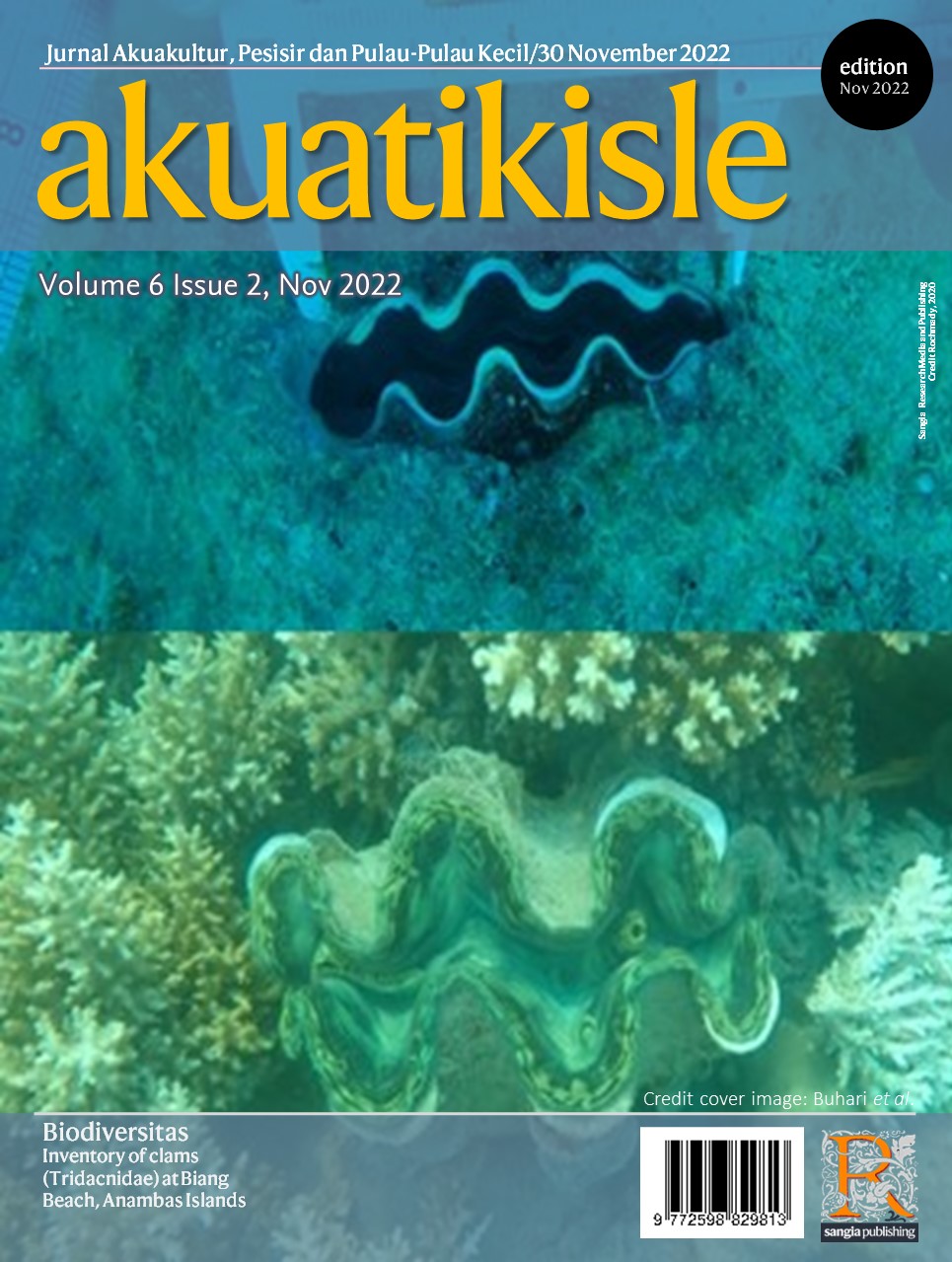Akuatikisle: Jurnal Akuakultur, Pesisir dan Pulau-Pulau Kecil
Full Length Article
Community structure of the Fiddler Crab (Uca spp.) at Bahak Indah Beach, Tongas, Probolinggo – East Java
Highlights
Generate NLP AI by Wizdam ID.
Abstract
The fiddler crab (Uca spp.) is a type of animal belonging to the crustacean group that lives on the coast of Bahak Indah, Tongas, Probolinggo. The high level of anthropogenic activity on the beach of Bahak Indah makes the fiddler crab community increasingly depressed and its habitat decreasing. The purpose of this study was to compare the community structure of fiddler crabs at Bahak Beach, Tongas, Probolinggo. The study was conducted in January – February 2022. The determination of observation stations was purposive based on the consideration of the presence and absence of mangrove vegetation. Sampling of fiddler crabs used a systematic sampling method using transects and plots. Community structure data analysis includes diversity, uniformity, and dominance indices displayed in graphical form. Based on the results of the study found 4 types of fiddler crabs in Bahak Indah Beach, namely Uca cryptica, Uca perplexa, Uca coarctata, and Uca dussumieri. The value of diversity on the beach with mangrove habitat is in the medium category, while on the beach habitat without mangrove vegetation it is in the low category. The uniformity value obtained in mangrove habitats is in the high category, while in coastal habitats without mangrove vegetation it is found in the medium category. On the other hand, the dominance index value is in the low category in coastal habitats with mangrove vegetation, and the moderate category in coastal habitats without mangrove vegetation. The relationship between the Diversity (H') of the fiddler crab and the environmental conditions of the Bahak Indah Beach waters is that it has a positive correlation with water pH parameters with sufficient correlation and soil pH with a strong correlation. While the correlation with temperature parameters is strong but negative. Likewise, salinity is quite strong but negative.
Keywords
Introduction
Section snippets
Material and Methods
Materials and methods from the full-text PDF of this article cannot be displayed.
Results
Results from the full-text PDF of this article cannot be displayed.
Discussion
Discussion from the full-text PDF of this article cannot be displayed.
Conclusions
Conclusions from the full-text PDF of this article cannot be displayed.
Acknowledgment
Acknowledgment from the full-text PDF of this article cannot be displayed.
Funding Information
Universitas Islam Malang
Competing interest
The authors declare that they have no known competing financial interests or personal relationships that could have appeared to influence the work reported in this paper.
Conflict of interest
The authors declare that the research was conducted in the absence of any commercial or financial relationships that could be construed as a potential conflict of interest.
Ethical approval acknowledgements
No ethical approval required for this article. All procedures followed were in accordance with the ethical standards of the responsible committee on human experimentation (institutional and national) and with the Helsinki Declaration of 1975, as revised in 2008 (5)
Supplementary files
Data sharing not applicable to this article as no datasets were generated or analysed during the current study, and/or contains supplementary material, which is available to authorized users.
Bibliographic Information
Cite this article as:
-
Submitted
27 July 2022 -
Revised
4 November 2022 -
Accepted
15 November 2022 -
Published
20 November 2022 -
Version of record
2 December 2022 -
Issue date
30 November 2022
-
Academic subject
Marine Science; Environmental Science
Copyright
Copyright © 2022 Nur Malichatin, Husain Latuconsina, Hasan Zayadi. Sangia Research Media and Publishing. Production and hosting by Sangia (SRM™).  This work is licensed under a Creative Commons Attribution-ShareAlike 4.0 International License.
This work is licensed under a Creative Commons Attribution-ShareAlike 4.0 International License.
Disclaimer: All claims expressed in this article are solely those of the authors and do not necessarily represent those of their affiliated organizations, or those of the publisher, the editors and the reviewers. Any product that may be evaluated in this article or claim that may be made by its manufacturer is not guaranteed or endorsed by the publisher.
Comments on this article
By submitting a comment you agree to abide by our Terms and Community Guidelines. If you find something abusive or that does not comply with our terms or guidelines please flag it as inappropriate.


